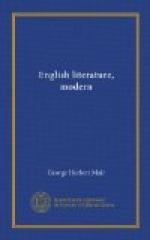Is it finally Samson Agonistes?
“His servants he with new acquist,
Of true experience from this great event,
With peace and consolation hath dismist,
And calm of mind all passion spent.”
“Calm of mind, all passion spent,” it is the essence of Milton’s art.
He worked in large ideas and painted splendid canvases; it was necessary for him to invent a style which should be capable of sustained and lofty dignity, which should be ornate enough to maintain the interest of the reader and charm him and at the same time not so ornate as to give an air of meretricious decoration to what was largely and simply conceived. Particularly it was necessary for him to avoid those incursions of vulgar associations which words carelessly used will bring in their train. He succeeded brilliantly in this difficult task. The unit of the Miltonic style is not the phrase but the word, each word fastidiously chosen, commonly with some air of an original and lost meaning about it, and all set in a verse in which he contrived by an artful variation of pause and stress to give the variety which other writers had from rhyme. In this as in his structure he accomplished what the Renaissance had only dreamed. Though he had imitators (the poetic diction of the age following is modelled on him) he had no followers. No one has been big enough to find his secret since.
CHAPTER V
THE AGE OF GOOD SENSE
The student of literature, when he passes in his reading from the age of Shakespeare and Milton to that of Dryden and Pope, will be conscious of certain sharply defined differences between the temper and styles of the writers of the two periods. If besides being a student of literature he is also (for this is a different thing) a student of literary criticism he will find that these differences have led to the affixing of certain labels—that the school to which writers of the former period belong is called “Romantic” and that of the latter “Classic,” this “Classic” school being again overthrown towards the end of the eighteenth century by a set of writers who unlike the Elizabethans gave the name “Romantic” to themselves. What is he to understand by these two labels; what are the characteristics of “Classicism” and how far is it opposite to and conflicting with “Romanticism”? The question is difficult because the names are used vaguely and they do not adequately cover everything that is commonly put under them. It would be difficult, for instance, to find anything in Ben Jonson which proclaims him as belonging to a different school from Dryden, and perhaps the same could be said in the second and self-styled period of Romanticism of the work of Crabbe. But in the main the differences are real and easily visible, even though they hardly convince us that the names chosen are the happiest that could be found by way of description.




